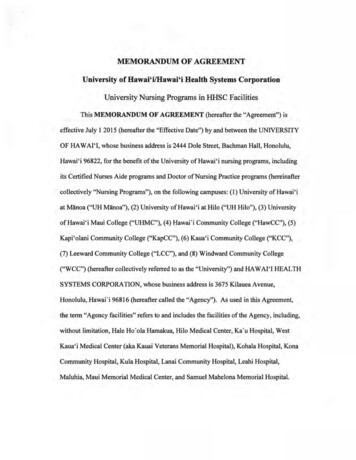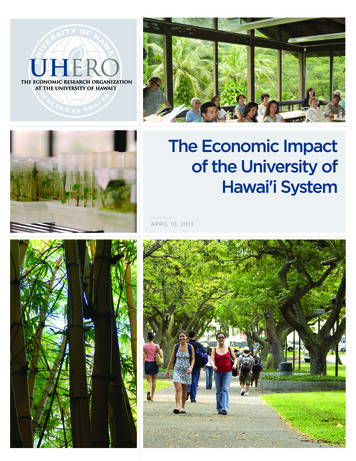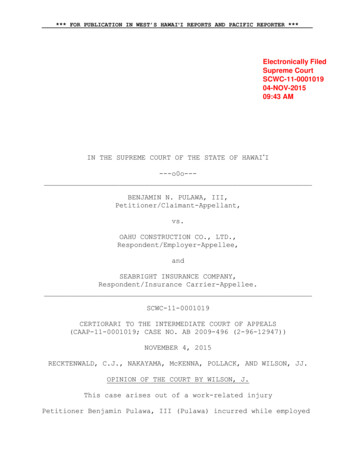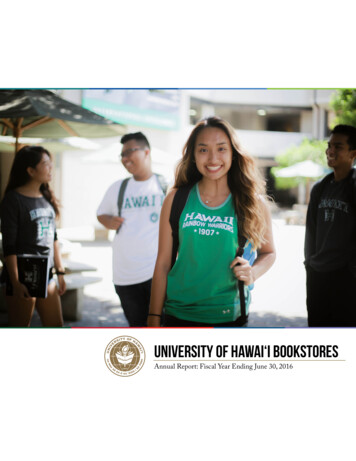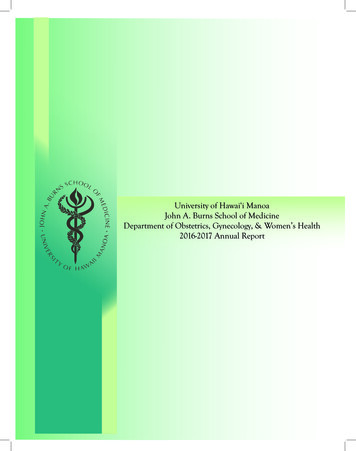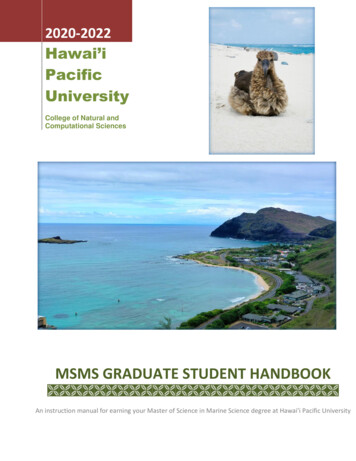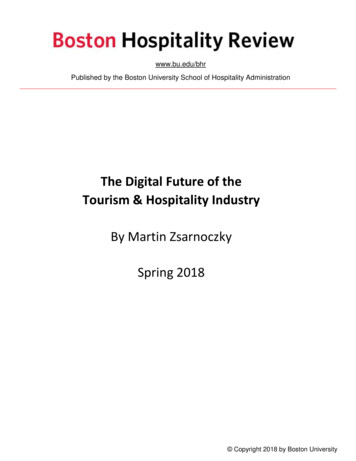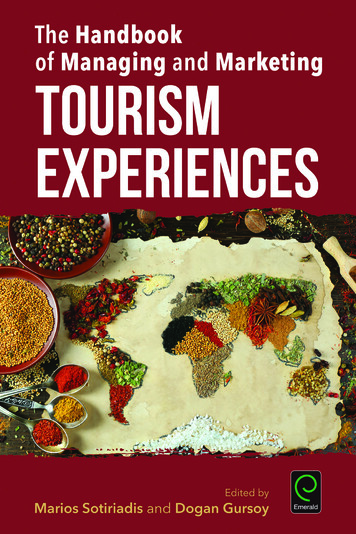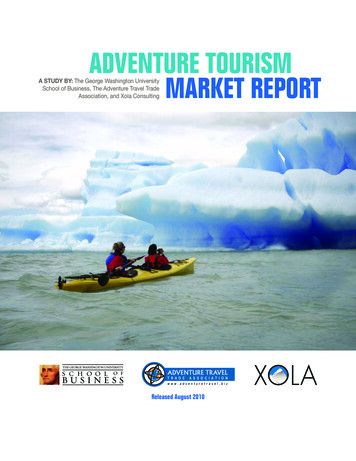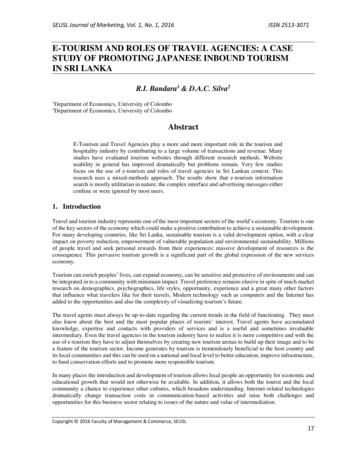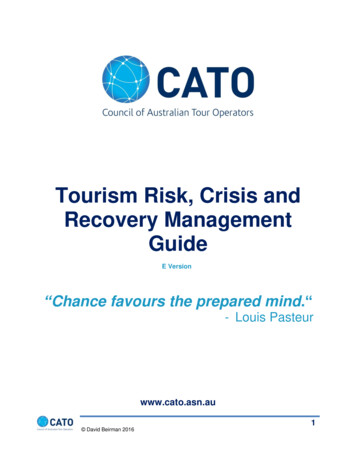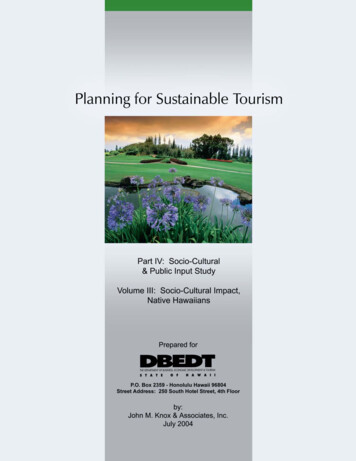
Transcription
JOHN M. KNOX & ASSOCIATES, INC.Sustainable Tourism in Hawai iSocio-Cultural and Public Input ComponentVolume III: Socio-Cultural Impacts ofTourism in Hawai i –Impacts on Native HawiiansPrepared for the Project: Planning for Sustainable Tourism in Hawai iHawai i State Department of Business, Economic Development & TourismPrepared by:Sustainable Tourism Study Native Hawaiian Advisory Group(Peter Apo, Dennis “Bumpy” Kanahele, Cherlyn Logan, Dr. Davianna McGregor)Editing/Facilitation:John M. Knox & Associates, Inc.(John Knox, Aja Kaikilani Devoll)August 20031001 Bishop St., ASB Tower 1542 Honolulu, Hawaii 96813 USA Phone (808) 523-1352 Fax (808) 523-1353 E-Mail jmk@lava.net
Hawaii Sustainable Tourism Study: Socio-Cultural Impacts on Native HawaiiansAugust 2003INTRODUCTORY COMMENTThis is the first of a two-part report on “Socio-Cultural Impacts of Tourism in Hawai i.” The present volume examinesimpacts on Native Hawaiians in particular, while the second part considers socio-cultural impact issues and impacts forthe General Population of Hawai i.The authors of the present report are the members of the Sustainable Tourism Study’s Native Hawaiian Advisory Group:Peter Apo – Director, Hawai i Hospitality InstituteDennis “Bumpy” Kanahele – Director, Kanaka Maoli Research & Development Corp.Cherlyn Logan – Vice Pres., Human Resources, Hilton Hotels Western RegionDr. Davianna McGregor – Associate Professor, University of Hawai i Ethnic Studies Dept.John M. Knox & Associates, Inc. provided logistical support, meeting facilitation, reflection on initial drafts, and finalediting/formatting. However, the final content is the work of Advisory Group members, and conclusions andrecommendations are theirs alone.To our knowledge, this is the first State-sponsored attempt to analyze the visitor industry’s impacts on Native Hawaiiansfrom a Native Hawaiian perspective.Introduction and ContentsPage i
This report has been cataloged as follows:Hawaii. Dept. of Business, Economic Development and Tourism.Planning for sustainable tourism. Honolulu: 2005.Multiple volume report by various authors.1. Tourism-Planning-Hawaii. 2. Tourism-Government policy-Hawaii. 3. Sustainable development-Hawaii.G155.H3.H32.2005
Hawaii Sustainable Tourism Study: Socio-Cultural Impacts on Native HawaiiansAugust 2003CONTENTSI.PREAMBLE – IMPACT ON NATIVE HAWAIIANS: AN OVERVIEWI-1Fair ReportingThe ChallengeThe Business ModelHistorical ContextNative Hawaiians and LandThe Good NewsSustaining Native Hawaiian Good WillI-1I-1I-2I-3I-3I-4I-5II.TOURISM IMPACTS ON NATIVE HAWAIIANS: SUMMARY TABLEII-1III.BEST PRACTICESCriteria and OrganizationCategoriesIII-1III-21. Special Projects2. Architecture3. Accommodations4. Attractions5. Environmental Preservation6. Events7. Historic ntinued)Introduction and ContentsPage ii
Hawaii Sustainable Tourism Study: Socio-Cultural Impacts on Native HawaiiansAugust 2003CONTENTS (Continued)8. Landscaping9. Literary Arts10. Broadcast Media11. Print Media12. Performing Arts13. Programs14. Restaurants and Food Service15. Retail16. Visual -9III-10III-11III-11IV-1APPENDICESA.MILESTONE HISTORICAL EVENTS IMPACTING THE NATIVE HAWAIIAN PEOPLE AND THECHALLENGES OF THEIR POLITICAL, SOCIAL, AND ECONOMIC STATUS IN THEIR HOMELANDA-1B.NATIVE HAWAIIAN CULTURAL IMPACT ASSESSMENT MODELB-1C.LIST OF NATIVE HAWAIIAN CULTURAL RESOURCES LOCATED IN COASTAL ZONEMANAGEMENT AREASC-1Introduction and ContentsPage iii
Hawaii Sustainable Tourism Study: Socio-Cultural Impacts on Native HawaiiansAugust 2003I. PREAMBLE – IMPACT OF TOURISM ON NATIVE HAWAIIANS:AN OVERVIEWFAIR REPORTINGThis report is a series of observations and perspectives presented by an advisory group of Native Hawaiians. The authorsshare a long history of being actively engaged in the economic, socio-cultural, and political issues of the Native Hawaiiancommunity. We believe that our collective knowledge represents a deep reach into the community memory and that ourauthorship lends a measure of credibility for the Native Hawaiian perspectives presented here. Although no such reportcan occur without some degree of subjectivity, the panel made a great effort at fair reporting.THE CHALLENGEThe relationship between Native Hawaiians and tourism is much more complicated than can be succinctly presented foreasy analysis. Budget constraints preclude a comprehensive impact analysis model employing sophisticated analyticaltools and technologies that might meet higher standards of fact-finding. Instead, our abbreviated analytical model relies onour own observations of tourism impacts.To understand the Native Hawaiian view of tourism, one must be sensitive to the uneasy relationship between NativeHawaiians and the mainstream of Hawai i’s political and economic institutions. The tourism industry is the dominant subset of those institutions. That is, the industry does not exist in a vacuum and therefore cannot be totally isolated as a focalpoint for study. Tourism has to be considered as part of a larger landscape of historical conditions, circumstances, events,decisions, and attitudes that have resulted in a diminished status of Native Hawaiians as decision makers in Hawai i’seconomic future. In this context, Tourism rises as a present-day flashpoint on a long trail of historical disappointments.We believe the majority of Native Hawaiians do not fully and comfortably embrace the prevailing business model ofcorporate tourism as generally contributing to the betterment of conditions of Native Hawaiians. We are not trying to sayNative Hawaiians would deny that tourism brings economic benefits or disagree that tourism is an important activity for thePreamble – Impact of Tourism on Native Hawaiians: An OverviewPage I-1
Hawaii Sustainable Tourism Study: Socio-Cultural Impacts on Native HawaiiansAugust 2003State of Hawai i. But we are saying that, in our experience, many Native Hawaiians feel the industry’s growth hascontributed to a degradation of their cultural values; compromised their cultural integrity in the global market place;diminished their presence in Hawai i’s visitor centers; devalued their wahi-pana (sacred places); and seriouslycompromised a Native Hawaiian sense of place in places like Waikīkī.This assessment is subject to some “good news” about more positive recent directions, which we will discuss shortly.However, our initial focus must be on the larger picture, which involves the contrast between Native Hawaiian values andthe prevailing tourism business model.THE BUSINESS MODELThe irony is that the Native Hawaiian cultural model of ho okipa or hospitality – the practice of greeting and welcomingstrangers – ranks high as an important part of our cultural behavior system. Hawaiians have culturally developed our skillsas a hosting population to extremely high levels of sophistication. Few societies, if any, are better at hospitality thanNative Hawaiians. On the other hand, many of us are emphatically critical of the prevailing business model of tourismwhich is structured on a vastly different set of values. In fact, another irony is that Native Hawaiians have long beenasking the same fundamental question that prompts this study – Is Hawai i’s prevailing tourism model sustainable?A tourism experience occurs whenever the three elements of visitor, place, and host converge. Hawai i employs a typicaltourism business model which makes the visitor the most important element of the three. In the rush to accommodate avisitor’s every expectation, this model is now clearly on record as willing to sacrifice the place and the goodwill of the hostcommunity for the short term benefit of the visitor. This model eventually turns the place into looking like the place fromwhich the visitor was trying to escape.The preferred business model embraced by Native Hawaiians is a model that makes preserving the dignity and culturallandscape of the place as the most important element. Such models exist all over Europe where protection of the place,the institutions, the historic buildings, the landscapes, and the local cultures are what give these places their “market”value. Italy is particularly filled with township models such as Florence and Venice, where preservation of the place equalssustainable market share. Santa Fe, New Mexico is another example where preservation of place and native culturetranslated to a vigorous visitor industry. Emerging Pacific island destinations such as the Republic of Palau, nowconsidered the diving capital of the world, have learned that making the preservation of their cultural landscape andPreamble – Impact of Tourism on Native Hawaiians: An OverviewPage I-2
Hawaii Sustainable Tourism Study: Socio-Cultural Impacts on Native HawaiiansAugust 2003pristine marine environment is the reason for their steep upward tourism growth curve. Sustainability and the preservationof the cultural landscape is the new model of global tourism.Such a model is more sustainable because it preserves the goodwill of the host by celebrating the place and maintainsthe market value of the destination by preserving its cultural uniqueness. Under the Native Hawaiian model, the completepaving over of Waikīkī could never have happened and we would not now have to engage in elaborate and expensiveschemes to “restore Hawaiian-ness to Waikīkī”. As long as the visitor-first business model dominates industry decisionmaking, it would be valid to say that Native Hawaiians will continue to distance themselves from embracing tourism as asolution to their social, cultural, and economic issues, and that we will continue to cite tourism as part of the problem.HISTORICAL CONTEXTTourism today is Hawai i’s number one industry. It succeeds sugar and pineapple as the dominant economic driver of theHawaiian economy. Tourism permeates every aspect of the economic, social, and political life of Hawai i. It is joined in itsimportance to the economy by our military-industrial complex, which ironically also brings thousands of strangers toHawai i. These industries are the current political outcomes of a western economic system that resulted – without theapproval of Hawaiians and at the expense of their sovereignty – from the overthrow of Queen Lili uokalani. The growth ofthese industries did not happen with our consent, and they continue without our consent. It would be a mistake not toacknowledge the impact of tourism in this historical context.A historical chronology of events that maps the shifting relationship between Native Hawaiians and contemporary Hawai iis provided as Appendix A to this report.NATIVE HAWAIIANS AND LANDSo as tourism follows sugar, pineapple, and the military, they all comprise a chronology of reincarnations of politicallywesternized land stewardship systems that alienated many Native Hawaiians from their most fundamental cultural need –access to land. Some might argue that, under the old traditional system of land management, individual Native Hawaiiansdid not own their land and so they essentially have not technically suffered any “loss.” This is the kind of culturallyinsensitive argument that further alienates Native Hawaiians. Native Hawaiians did not individually own land because thewhole western concept of “owning” land was completely foreign to the cultural land stewardship model that had been inPreamble – Impact of Tourism on Native Hawaiians: An OverviewPage I-3
Hawaii Sustainable Tourism Study: Socio-Cultural Impacts on Native HawaiiansAugust 2003place for centuries and that provided unlimited opportunities for Hawaiians to access the land. When this traditionalsystem of access – which was absent private property rights – impeded the growth of ranches and plantations, amomentous change was imposed. The legal concept of private ownership was thrust upon the native population firstthrough the Māhele, a sweeping land division edict little understood by the maka āinana (commoners) followed by ablatantly obvious land grab scheme now historically infamous as the Law of Adverse Possession.To a Native Hawaiian, being alienated from access to land is a cultural tragedy of major proportions. Some might say it isunfair to connect this historical alienation to present-day tourism, since much of it occurred well before the visitor industrybecame a factor in Hawai i’s economy. However, from a Native Hawaiian perspective, as a business model tourismembraces the same concepts and values as its predecessors. It is a variation of an economic theme that yields the sameresult: Native Hawaiian alienation from their culture.Tourism has had the further debilitating effect of distorting the culture through commercially driven presentations that lackcultural depth and dignity. Our culture is further distorted by homogenized presentations that sandwich Hawaiian culturebetween layers of other Polynesian cultures so that it fails to be distinguishable as unique to the Hawaiian heritage.THE GOOD NEWSAttempting to cite the benefits that tourism brings to Native Hawaiians is also a challenge. Even when some aspect of theindustry appears to be a benefit, it may not be so beneficial when viewed through Native Hawaiian eyes. For example,employment provided by the industry is often held as an example of a tourism benefit for Native Hawaiians. Yet NativeHawaiians often do not feel particularly grateful, because many find industry policies unattractive and offensive. In ourexperience, a large number of Native Hawaiians feel they and their culture are unappreciated and disrespected. This isparticularly true for Native Hawaiian musicians and hula dancers who are continually reminded of how dispensable theyare each time the industry begins tightening its economic belt and the first services to be terminated are the musiciansand hula dancers.The good news is that opportunities for Native Hawaiians to benefit from tourism are growing. For instance, there is arising demand for genuine Native Hawaiian culture from hotels and other visitor institutions seeking to connect with NativeHawaiian cultural practitioners. Many institutions are embracing Native Hawaiian culture as good for their bottom line; arewilling to properly compensate for services; but don’t know how to access the services. This is a good problem. NativeHawaiian leaders are being sought out for consultation on matters of cultural protocol. In efforts at re-development or newPreamble – Impact of Tourism on Native Hawaiians: An OverviewPage I-4
Hawaii Sustainable Tourism Study: Socio-Cultural Impacts on Native HawaiiansAugust 2003development, there is also a heightened sensitivity to the need for restoring or maintaining Native Hawaiian culturalthemes. Nowhere is this more evident than at the economic heart of the industry – Waikīkī. As the demand rises for ahigher presence of Native Hawaiian culture in the market, there are many new opportunities for Hawaiianentrepreneurship. One of these is the opportunity for Native Hawaiians to tell their own story, on their own terms, withdignity and honor. There is new economic value being assigned to genuine Native Hawaiian culture that was absentduring the industry’s period of dynamic growth. Native Hawaiians would welcome culturally appropriate opportunities thattourism offers as a window to the world, because we believe we have something worthwhile to contribute to thebetterment of conditions of mankind.SUSTAINING NATIVE HAWAIIAN GOOD WILLThe great challenge of this sustainability study is determining how to get government and the industry to fully understandthe nature of the disconnect between the Native Hawaiian community and Hawai i’s visitor industry. Whether the issuesare “real” or “perceived,” the outcome is the same – loss of good will and increase in anti-tourism sentiment. Central to thequestion is not only sustaining the goodwill of the Native Hawaiian host culture, but also having a Native Hawaiian culturalpresence in high profile as part of both the marketing and the “product quality” planning. That is, Native Hawaiian voicesmust be heard in order to ensure the destination retains a unique sense of place and therefore heightened value in themarketplace. We are hopeful this study will bring us a step closer to building a bridge of understanding between the hostNative Hawaiian culture and the visitor industry.Preamble – Impact of Tourism on Native Hawaiians: An OverviewPage I-5
Hawaii Sustainable Tourism Study: Socio-Cultural Impacts on Native HawaiiansAugust 2003II. TOURISM IMPACTS ON NATIVE HAWAIIANS (SUMMARY TABLE)Purpose of This Section: Sustaining the cultural and natural resources of our islands and surrounding reefs and oceanis a responsibility inherited by Native Hawaiians and all those for whom Hawai i is home. Hawaiian laws recognize thisresponsibility and have afforded rights of access to natural and cultural resources for customary and traditional NativeHawaiian cultural, religious, and subsistence purposes (HRS 7-1, HRS 1-1, Hawai i State Constitution, Article XII. Section7).The activities and programs related to tourism impact the sustainability of Native Hawaiian cultural and natural resourcesin a variety of ways. The Advisory Group identified 10 aspects of tourist operations that we believe impact NativeHawaiian communities, families and the Native Hawaiian nation as a whole. We acknowledge this is not a complete list ofactivities or impacts. We hope it can serve to stimulate thinking about tourism and the sustainability of Native Hawaiiancultural and natural resources.The 10 aspects of tourist operations include: (1) Property Development and Management, (2) Operations, Activities,Programs, (3) Human Resources – Employer to Worker/ Worker to Worker, (4) Entertainment, (5) Purchase of LocalProducts and Services, (6) Entrepreneurial Opportunities for Community, (7) Relation to Surrounding Community, (8) Roleof Government, (9) Planning Projections, and (10) Tourists, Offshore Landowners, In-Migrants. Some of these have beencombined for purposes of the following Summary Table.How to Read Summary Table: In the following table of impacts, the first column lists observed impacts of tourism uponNative Hawaiians. The second column describes how the observed impact is specifically related to tourism, as comparedto broader economic changes. The third column suggests methods that can be employed to measure the identifiedimpacts or to monitor them (i.e., repeated observations over time). In some cases, it also suggests possible futureresearch activities that could test to what extent the assumed impacts are actually present, or under what conditions theyare most likely to occur.Attached appendices expand upon the table. Appendix B provides a detailed identification of Native Hawaiian culturalresources and potential impacts by any development – tourist and non-tourist. Appendix C identifies cultural resourceslocated in the coastal zone of our islands.Tourism Impacts on Native Hawaiians (Summary Table)Page II-1
Hawaii Sustainable Tourism Study: Socio-Cultural Impacts on Native HawaiiansAugust 2003LIST OF OBSERVED TOURISM IMPACTS ON NATIVE HAWAIIANS1. Property Development and Management / 2. Operations, Activities, ProgramsImpactRelation to Tourism and BroaderEconomic ChangesMethods to Measure and Monitor Impactsas Related to Tourist ActivitiesMeasure/Monitor: Marine catch reportscomparing catch relative to time and effortspent over the past years.Monitor: Repeated surveys of marineresources.Change in natural cultural resources neededby Hawaiians who rely upon subsistenceactivities (i.e., preserving last vestiges oftraditional lifestyles). Such changes includeeffects on abundance, quality, and access tothings such as native plants, fish, andmarine resources. See Appendices I and IIfor list of resources.Most of this comes from populationgrowth and “modernization” that couldhave been due to an
Peter Apo – Director, Hawai i Hospitality Institute Dennis “Bumpy” Kanahele – Director, Kanaka Maoli Research & Development Corp. Cherlyn Logan – Vice Pres., Human Resources, Hilton Hotels Western Region Dr. Davianna McGregor – Associ
